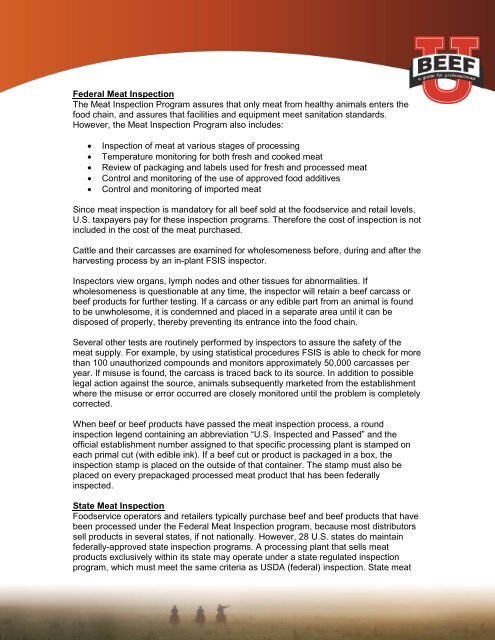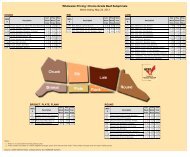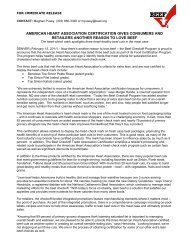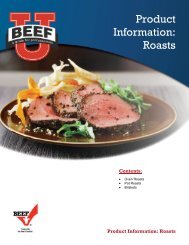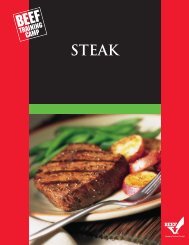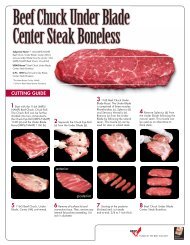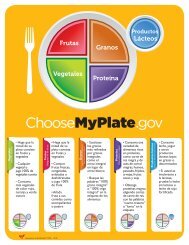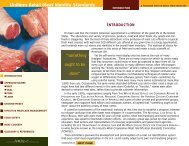Fact Sheet - Beef Foodservice
Fact Sheet - Beef Foodservice
Fact Sheet - Beef Foodservice
Create successful ePaper yourself
Turn your PDF publications into a flip-book with our unique Google optimized e-Paper software.
Federal Meat Inspection<br />
The Meat Inspection Program assures that only meat from healthy animals enters the<br />
food chain, and assures that facilities and equipment meet sanitation standards.<br />
However, the Meat Inspection Program also includes:<br />
• Inspection of meat at various stages of processing<br />
• Temperature monitoring for both fresh and cooked meat<br />
• Review of packaging and labels used for fresh and processed meat<br />
• Control and monitoring of the use of approved food additives<br />
• Control and monitoring of imported meat<br />
Since meat inspection is mandatory for all beef sold at the foodservice and retail levels,<br />
U.S. taxpayers pay for these inspection programs. Therefore the cost of inspection is not<br />
included in the cost of the meat purchased.<br />
Cattle and their carcasses are examined for wholesomeness before, during and after the<br />
harvesting process by an in-plant FSIS inspector.<br />
Inspectors view organs, lymph nodes and other tissues for abnormalities. If<br />
wholesomeness is questionable at any time, the inspector will retain a beef carcass or<br />
beef products for further testing. If a carcass or any edible part from an animal is found<br />
to be unwholesome, it is condemned and placed in a separate area until it can be<br />
disposed of properly, thereby preventing its entrance into the food chain.<br />
Several other tests are routinely performed by inspectors to assure the safety of the<br />
meat supply. For example, by using statistical procedures FSIS is able to check for more<br />
than 100 unauthorized compounds and monitors approximately 50,000 carcasses per<br />
year. If misuse is found, the carcass is traced back to its source. In addition to possible<br />
legal action against the source, animals subsequently marketed from the establishment<br />
where the misuse or error occurred are closely monitored until the problem is completely<br />
corrected.<br />
When beef or beef products have passed the meat inspection process, a round<br />
inspection legend containing an abbreviation “U.S. Inspected and Passed” and the<br />
official establishment number assigned to that specific processing plant is stamped on<br />
each primal cut (with edible ink). If a beef cut or product is packaged in a box, the<br />
inspection stamp is placed on the outside of that container. The stamp must also be<br />
placed on every prepackaged processed meat product that has been federally<br />
inspected.<br />
State Meat Inspection<br />
<strong>Foodservice</strong> operators and retailers typically purchase beef and beef products that have<br />
been processed under the Federal Meat Inspection program, because most distributors<br />
sell products in several states, if not nationally. However, 28 U.S. states do maintain<br />
federally-approved state inspection programs. A processing plant that sells meat<br />
products exclusively within its state may operate under a state regulated inspection<br />
program, which must meet the same criteria as USDA (federal) inspection. State meat


